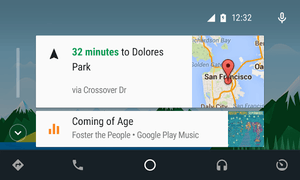Android Auto
|
| |
 | |
| Original author(s) | |
|---|---|
| Developer(s) | |
| Initial release | March 19, 2015 |
| Development status | Active |
| Operating system | Android 5.0+ ("Lollipop") |
| Type | Telematics |
| License | Proprietary |
| Website |
www |
Android Auto is a smartphone projection standard developed by Google to allow mobile devices running the Android operating system (version 5.0 "Lollipop" and later) to be operated in automobiles through the dashboard's head unit. Android Auto was announced on June 25, 2014, at Google I/O 2014. The Android Auto mobile app was released on March 19, 2015.
The standard offers drivers control over GPS mapping/navigation, music playback, SMS, telephony, and web search; both touchscreen and button-controlled head unit displays will be supported, although hands-free operation through voice commands is emphasized to ensure safe driving. Compatible apps include Google Maps, Google Play Music, MLB at Bat, Spotify, Songza, Stitcher, iHeart Radio, Radioplayer, and TuneIn.
While the official Android Auto website does list most car manufacturers as supporting Android Auto, many vehicles which are released for the 2015 and 2016 model years do not officially support it just yet.
Android Auto is part of the Open Automotive Alliance, which was announced on January 6, 2014, and is a joint effort with 28 automobile manufacturers and mobile tech supplier Nvidia. In May 2015, Hyundai became the first manufacturer to offer Android Auto, making it available first in the 2015 Hyundai Sonata.
Functionality
The aim of Android Auto is to extend the functionality of an Android mobile device in an automobile to the dashboard's head unit. In order to use the system, users must be running Lollipop on their mobile device and must own a vehicle supporting Android Auto.[1] The driver's Android device connects to the vehicle via USB cable.[2] Rather than running its own operating system, the head unit will serve as an external display for the Android device, which runs all of the software, by presenting a car-specific user interface built into Lollipop.[1][3]
Several functions are supported:
- GPS mapping/navigation
- Music control
- Telephony
- SMS composition and playback
- Web search
An Android Auto software development kit (SDK) has been released, allowing third parties to modify their apps to work with Android Auto;[3] APIs will be only available for music and messaging apps initially.[4][5]
Car hardware support
With Android Auto, a driver's mobile device will have access to several of the automobile's sensors and inputs:[6]
| Car hardware | Available to mobile device |
|---|---|
| GPS and high-quality GPS antennas | Yes |
| Steering-wheel mounted buttons | Yes |
| Sound system | Yes |
| Directional speakers | Yes |
| Directional microphones | Yes |
| Wheel speed | Yes |
| Compass | Yes |
| Car data | Under development |
| Mobile antennas | Yes |
Partnering manufacturers and suppliers
Automobile manufacturers that will be offering Android Auto in their cars include Abarth, Acura, Alfa Romeo, Audi, Bentley, BMW, Chevrolet, Chrysler, Dodge, Fiat, Ford, GMC, Honda, Hyundai, Infiniti, Jaguar Land Rover, Jeep, Kia, Lamborghini, Lexus, Lincoln, Mahindra and Mahindra, Maserati, Mazda, Mercedes-Benz, Mitsubishi, Nissan, Opel, RAM, Renault, SEAT, Škoda, Subaru, Suzuki, Tata Motors Cars, Volkswagen, Volvo. Suppliers include Kenwood and Pioneer.[4]
Launch partners
The following models are available with Android Auto:
- Hyundai Sonata (May 2015)
- Skoda Fabia (June 2015)
- Skoda Rapid (June 2015)
- Skoda Superb (June 2015)
- Skoda Octavia (June 2015)
- VW Fox (June 2015)[7]
- Honda Accord (August 2015)[8]
- Audi Q7 (August 2015)
- Honda Civic (September 2015)[9]
- VW Golf/GTI/R (September 2015/2016)
- VW Touran II (September 2015)
- Mitsubishi Pajero (September 2015)
Many other models are now equipped with Android Auto. To see a complete list of manufactures and Google Auto vehicles, visit Google's website.[10]
Aftermarket units
Several aftermarket car audio systems have been released that include Android Auto, including Pioneer,[11] Kenwood[12] and Panasonic [13]
See also
References
- 1 2 Devine, Richard (June 26, 2014). "What you need to know about Android Auto". Android Central. Retrieved June 27, 2014.
- ↑ Gorman, Michael (June 25, 2014). "Google gives us a simulated ride with Android Auto". Engadget. AOL Inc. Retrieved June 26, 2014.
- 1 2 Goodwin, Antuan (June 25, 2014). "Google's new Android Auto is like Google Now for your car". CNET. CBS Interactive. Retrieved June 26, 2014.
- 1 2 Moynihan, Tim (June 25, 2014). "Google Announces Android Auto, Its Answer to Apple's CarPlay". Wired. Condé Nast. Retrieved June 26, 2014.
- ↑ "Autoradio GPS". Archived from the original on March 17, 2016. Retrieved March 17, 2016.
- ↑ Brenner, Andy (June 27, 2014). "Google I/O 2014 - Android Auto: Developers, Start Your Engines!". YouTube. Google. Retrieved July 5, 2014.
- ↑ https://tecnoblog.net/179118/fox-2016-carplay-android-auto/
- ↑ http://www.hondanews.com/releases/honda-introduces-the-highest-tech-accord-yet-in-high-tech-s-u-s-hub-silicon-valley
- ↑ http://www.androidcentral.com/2016-honda-civic-introduces-support-android-auto
- ↑ https://www.android.com/auto/
- ↑ "Pioneer-Android-Auto". Retrieved 28 August 2015.
- ↑ "Kenwood-Android-Auto". Retrieved January 4, 2016.
- ↑ "Android Auto for Panasonic". Android. Retrieved 2016-11-17.
